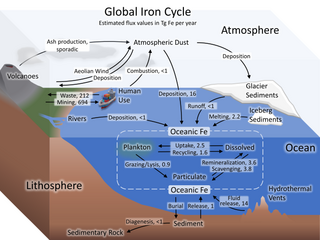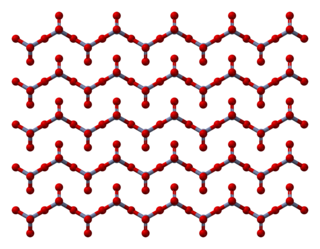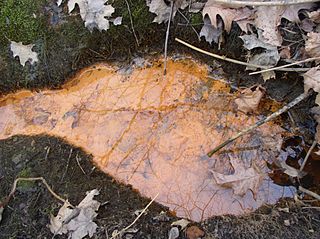
The chromium cycle is the biogeochemical cycle of chromium through the atmosphere, hydrosphere, biosphere and lithosphere. [1] [2] [3] [4]

The chromium cycle is the biogeochemical cycle of chromium through the atmosphere, hydrosphere, biosphere and lithosphere. [1] [2] [3] [4]
| Part of a series on |
| Biogeochemical cycles |
|---|
 |
Chromium has two common oxidation states relevant for environmental conditions: trivalent chromium, Cr(III) (reduced form), and hexavalent chromium, Cr(VI) (most oxidized form). The poorly soluble trivalent chromium cation (Cr3+
) strongly adsorbs onto clay particles and particulate organic matter, whereas the highly toxic and carcinogenic hexavalent chromate anion (CrO2−
4) is soluble and non-sorbed, making it a toxic contaminant in environmental systems. Chromium commonly exists in soil and rocks as highly insoluble trivalent chromium, such as chromite (Fe(II)Cr(III)
2O
4, or FeO·Cr
2O
3), a mixed oxide mineral of the spinel group resembling magnetite (Fe
3O
4, Fe(II)Fe(III)
2O
4, or FeO·Fe
2O
3). Terrestrial weathering could cause trivalent chromium to be oxidized by manganese oxides to hexavalent chromium, which is then solubilized and cycled to the ocean through rivers. Estuaries release particulate chromium from rivers to the sea, increasing the dissolved fluxes of chromium to the ocean. [1]
Soluble hexavalent chromium is the most common type of chromium in oceans, where over 70% of dissolved chromium in the ocean is found in oxyanions such as chromate (CrO2−
4). Soluble trivalent chromium is also found in the oceans where complexation with organic ligands occurs. Chromium is estimated to have a residence time of 6,300 years in the oceans. Hexavalent chromium is reduced to trivalent chromium in oxygen minimum zones or at the surface of the ocean by divalent iron and organic ligands. There are four sinks of chromium from the oceans: (1) oxic sediments in pelagic zones, (2) hypoxic sediments in continental margins, (3) anoxic or sulfidic sediments in basins or fjords with permanently anoxic or sulfidic (euxinic) bottom waters, and (4) marine carbonates. [1]
Manganese (III) can oxidize Cr(III) to Cr(VI) when complexed with organic ligands. [5] This causes contaminant mobilization of Cr(VI), and also reduces Mn(III) to Mn(II), which can then be oxidized back to Mn(III) by oxygen. [5]
Isotopic fractionation of chromium has become a valuable tool for monitoring environmental chromium contamination through recent advancements in mass spectrometry. [1] Isotope fractionation during river transport is determined by local redox conditions based on dissolved organic matter in rivers. [1]

Chromium is a chemical element with the symbol Cr and atomic number 24. It is the first element in group 6. It is a steely-grey, lustrous, hard, and brittle transition metal.

An oxidizing agent is a substance in a redox chemical reaction that gains or "accepts"/"receives" an electron from a reducing agent. In other words, an oxidizer is any substance that oxidizes another substance. The oxidation state, which describes the degree of loss of electrons, of the oxidizer decreases while that of the reductant increases; this is expressed by saying that oxidizers "undergo reduction" and "are reduced" while reducers "undergo oxidation" and "are oxidized". Common oxidizing agents are oxygen, hydrogen peroxide and the halogens.
The term chromic acid is usually used for a mixture made by adding concentrated sulfuric acid to a dichromate, which may contain a variety of compounds, including solid chromium trioxide. This kind of chromic acid may be used as a cleaning mixture for glass. Chromic acid may also refer to the molecular species, H2CrO4 of which the trioxide is the anhydride. Chromic acid features chromium in an oxidation state of +6 (or VI). It is a strong and corrosive oxidising agent.

Chromate salts contain the chromate anion, CrO2−
4. Dichromate salts contain the dichromate anion, Cr
2O2−
7. They are oxyanions of chromium in the +6 oxidation state and are moderately strong oxidizing agents. In an aqueous solution, chromate and dichromate ions can be interconvertible.

Chromite is a crystalline mineral composed primarily of iron(II) oxide and chromium(III) oxide compounds. It can be represented by the chemical formula of FeCr2O4. It is an oxide mineral belonging to the spinel group. The element magnesium can substitute for iron in variable amounts as it forms a solid solution with magnesiochromite (MgCr2O4). A substitution of the element aluminium can also occur, leading to hercynite (FeAl2O4). Chromite today is mined particularly to make stainless steel through the production of ferrochrome (FeCr), which is an iron-chromium alloy.

Potassium dichromate, K2Cr2O7, is a common inorganic chemical reagent, most commonly used as an oxidizing agent in various laboratory and industrial applications. As with all hexavalent chromium compounds, it is acutely and chronically harmful to health. It is a crystalline ionic solid with a very bright, red-orange color. The salt is popular in the laboratory because it is not deliquescent, in contrast to the more industrially relevant salt sodium dichromate.

The iron cycle (Fe) is the biogeochemical cycle of iron through the atmosphere, hydrosphere, biosphere and lithosphere. While Fe is highly abundant in the Earth's crust, it is less common in oxygenated surface waters. Iron is a key micronutrient in primary productivity, and a limiting nutrient in the Southern ocean, eastern equatorial Pacific, and the subarctic Pacific referred to as High-Nutrient, Low-Chlorophyll (HNLC) regions of the ocean.

Chromium trioxide (also known as chromium(VI) oxide or chromic anhydride) is an inorganic compound with the formula CrO3. It is the acidic anhydride of chromic acid, and is sometimes marketed under the same name. This compound is a dark-purple solid under anhydrous conditions, bright orange when wet and which dissolves in water concomitant with hydrolysis. Millions of kilograms are produced annually, mainly for electroplating. Chromium trioxide is a powerful oxidiser and a carcinogen.

Pitting corrosion, or pitting, is a form of extremely localized corrosion that leads to the random creation of small holes in metal. The driving power for pitting corrosion is the depassivation of a small area, which becomes anodic while an unknown but potentially vast area becomes cathodic, leading to very localized galvanic corrosion. The corrosion penetrates the mass of the metal, with a limited diffusion of ions.

The sulfur cycle is a biogeochemical cycle in which the sulfur moves between rocks, waterways and living systems. It is important in geology as it affects many minerals and in life because sulfur is an essential element (CHNOPS), being a constituent of many proteins and cofactors, and sulfur compounds can be used as oxidants or reductants in microbial respiration. The global sulfur cycle involves the transformations of sulfur species through different oxidation states, which play an important role in both geological and biological processes. Steps of the sulfur cycle are:

Hexavalent chromium is chromium in any chemical compound that contains the element in the +6 oxidation state. Virtually all chromium ore is processed via hexavalent chromium, specifically the salt sodium dichromate. Hexavalent chromium is key to all materials made from chromium. Approximately 136,000 tonnes of hexavalent chromium were produced in 1985.

Iron-oxidizing bacteria are chemotrophic bacteria that derive energy by oxidizing dissolved ferrous iron. They are known to grow and proliferate in waters containing iron concentrations as low as 0.1 mg/L. However, at least 0.3 ppm of dissolved oxygen is needed to carry out the oxidation.
Anoxic waters are areas of sea water, fresh water, or groundwater that are depleted of dissolved oxygen. The US Geological Survey defines anoxic groundwater as those with dissolved oxygen concentration of less than 0.5 milligrams per litre. Anoxic waters can be contrasted with hypoxic waters, which are low in dissolved oxygen. This condition is generally found in areas that have restricted water exchange.

Chromium is a member of group 6, of the transition metals. The +3 and +6 states occur most commonly within chromium compounds, followed by +2; charges of +1, +4 and +5 for chromium are rare, but do nevertheless occasionally exist.

The phosphorus cycle is the biogeochemical cycle that describes the movement of phosphorus through the lithosphere, hydrosphere, and biosphere. Unlike many other biogeochemical cycles, the atmosphere does not play a significant role in the movement of phosphorus, because phosphorus and phosphorus-based compounds are usually solids at the typical ranges of temperature and pressure found on Earth. The production of phosphine gas occurs in only specialized, local conditions. Therefore, the phosphorus cycle should be viewed from whole Earth system and then specifically focused on the cycle in terrestrial and aquatic systems.

Chromium(III) sulfate usually refers to the inorganic compounds with the formula Cr2(SO4)3.x(H2O), where x can range from 0 to 18. Additionally, ill-defined but commercially important "basic chromium sulfates" are known. These salts are usually either violet or green solids that are soluble in water. It is commonly used in tanning leather.
Chromium toxicity refers to any poisonous toxic effect in an organism or cell that results from exposure to specific forms of chromium—especially hexavalent chromium. Hexavalent chromium and its compounds are toxic when inhaled or ingested. Trivalent chromium is a trace mineral that is essential to human nutrition. There is a hypothetical risk of genotoxicity in humans if large amounts of trivalent chromium were somehow able to enter living cells, but normal metabolism and cell function prevent this.

Chromium(VI) peroxide or chromium oxide peroxide is an unstable compound with the formula CrO5. This compound contains one oxo ligand and two peroxo ligands, making a total of five oxygen atoms per chromium atom.
Oxidation with chromium(VI) complexes involves the conversion of alcohols to carbonyl compounds or more highly oxidized products through the action of molecular chromium(VI) oxides and salts. The principal reagents are Collins reagent, PDC, and PCC. These reagents represent improvements over inorganic chromium(VI) reagents such as Jones reagent.

The gold cycle is the biogeochemical cycling of gold through the lithosphere, hydrosphere, atmosphere, and biosphere. Gold is a noble transition metal that is highly mobile in the environment and subject to biogeochemical cycling, driven largely by microorganisms. Gold undergoes processes of solubilization, stabilization, bioreduction, biomineralization, aggregation, and ligand utilization throughout its cycle. These processes are influenced by various microbial populations and cycling of other elements such as carbon, nitrogen, and sulfur. Gold exists in several forms in the Earth's surface environment including Au(I/III)-complexes, nanoparticles, and placer gold particles. The gold biogeochemical cycle is highly complex and strongly intertwined with cycling of other metals including silver, copper, iron, manganese, arsenic, and mercury. Gold is important in the biotech field for applications such as mineral exploration, processing and remediation, development of biosensors and drug delivery systems, industrial catalysts, and for recovery of gold from electronic waste.
{{cite web}}: CS1 maint: url-status (link){{cite web}}: CS1 maint: url-status (link)